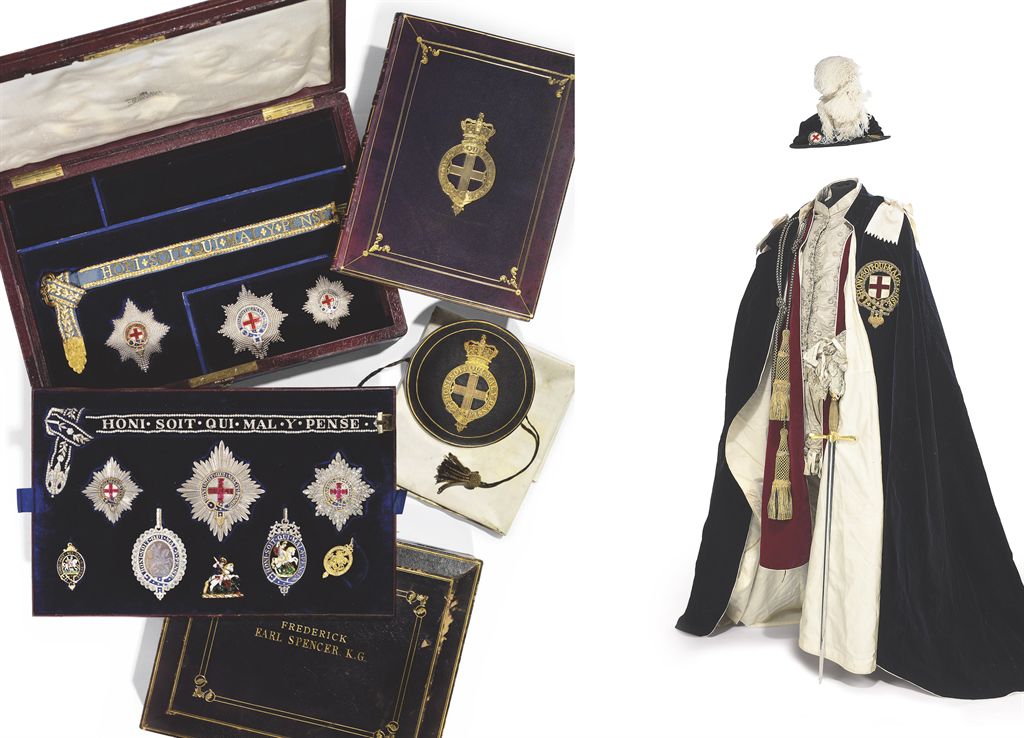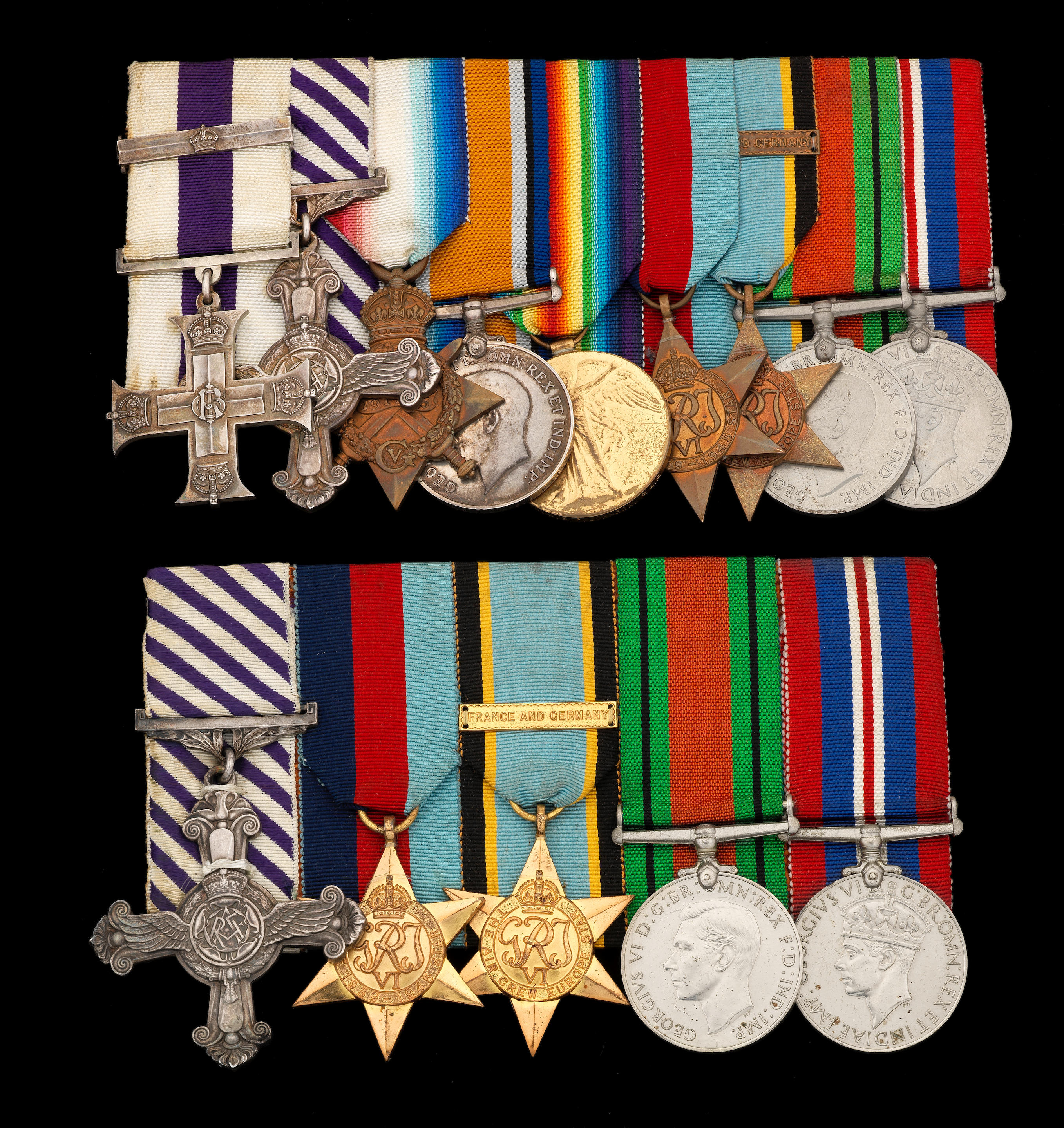The unique D.S.O. group of ten awarded to Lieutenant-Colonel H. J. Jones, 14th Sikhs, for gallantry at the Koragh Defile in March 1895, from which disaster only Lieutenant Jones and 14 of his men emerged alive, all the surviving Sikhs being awarded the I.O.M. Distinguished Service Order, V.R., silver-gilt and enamels; Egypt and Sudan 1882-891 clasp, The Nile 1884-85 (Lieut. H. J. Jones. 1/Rl. Ir: Regt.) naming re-engraved; India General Service 1854-94, 1 clasp, Hazara 1888 (Lieut. H. J. Jones 14th Bl. Infy.); India General Service 1895-1902, 2 clasps, Relief of Chitral 1895, Punjab Frontier 1897-98 (Lieut. H. J. Jones. 14th Bl. Infy.); China 1900, no clasp (Captn. H. J. Jones. D.S.O. 14th Sikh Infy.); 1914-15 Star (Lt: Col: H. J. Jones. D.S.O. Manch: R.); British War and Victory Medals (Lt. Col. H. J. Jones.); Delhi Durbar 1911; Khedive’s Star 1884-6, mounted as worn, light contact marks to the earlier medals, these very fine, otherwise extremely fine (10) £5000-7000 Footnote Herbert John Jones was born in Auckland, New Zealand, on 23 December 1865. He was commissioned into the Royal Irish Regiment on 12 August 1884, and served with the 1st Battalion in the Nile Expedition as part of the Desert Column, including the action at Abu Klea, 17 February 1885 (Medal with clasp; Bronze star). In March 1886 Jones transferred to the Indian Army and was posted to the 14th Sikh Regiment of Bengal Infantry. This famous regiment was raised in 1846 by Colonel Ross as “The Regiment of Ferozepore” recruited from Sikhs of the defeated Khalsa. After distinguished service in the Mutiny the regiment became the 14th Regiment of Bengal Infantry. Jones next saw action on the North West Frontier in the Hazara campaign of 1888. The 14th Sikhs left Jhelum in September 1888 and moved out with Number Three Column of the Hazara Field Force in October. There was little heavy fighting during the expedition but the 14th Sikhs formed the advance guard of the column and sustained a few casualties in brushing aside minor resistance from the tribesmen when moving into the area. The column camped at Akhund on the crest of the Black Mountain while small columns moved out and destroyed a number of villages without incident. The 14th Sikhs were back in Jhelum by Christmas. In 1890 the Regiment moved to Peshawar and spent three peaceful years there before being posted to Ferozepore in 1893. In 1891-92 Jones served in operations against the Kachins of Upper Burma, for which he received the thanks of the Government of India. In June 1894 the 14th Sikhs were ordered to provide an escort for the British political agent proceeding to Gilgit and ‘A’ and ‘B’ companies were detached for this role. ‘A’ Company, under Lieutenant H. K. Harley, subsequently formed the backbone of the garrison of Chitral when that place was besieged in March and April 1895, Harley being awarded the D.S.O. for his gallantry in the defence. The Koragh defile At the beginning of March 1895 ‘B’ Company, commanded by Captain C. R. Ross and Lieutenant H. J. Jones, was at Mastuj. Ross was the son of the founder of the regiment and was described by one colleague as ‘gallant to the point of eccentricity.’ A few days later information was received that an ammunition convoy was under attack near Reshun and the Company went to their assistance. The Sikhs halted the first night at Buni and, next morning (8th March), moved on. Soon after 1 p.m. the Company entered a narrow defile below the village of Koragh. The defile was about half a mile long and situated where the Mastuj River, a rapid and unfordable torrent, formed a gorge through the mountains. At the Koragh end the narrow path lay close to the river, then began to rise above some caves and zig-zag up a very steep spur at the Reshun end. Despite warnings from his guides, in his haste Ross refused to reconnoitre and led his entire company (two British officers, 94 Sikhs and 17 followers) into the defile. When they were about half-way up the spur, local tr
The unique D.S.O. group of ten awarded to Lieutenant-Colonel H. J. Jones, 14th Sikhs, for gallantry at the Koragh Defile in March 1895, from which disaster only Lieutenant Jones and 14 of his men emerged alive, all the surviving Sikhs being awarded the I.O.M. Distinguished Service Order, V.R., silver-gilt and enamels; Egypt and Sudan 1882-891 clasp, The Nile 1884-85 (Lieut. H. J. Jones. 1/Rl. Ir: Regt.) naming re-engraved; India General Service 1854-94, 1 clasp, Hazara 1888 (Lieut. H. J. Jones 14th Bl. Infy.); India General Service 1895-1902, 2 clasps, Relief of Chitral 1895, Punjab Frontier 1897-98 (Lieut. H. J. Jones. 14th Bl. Infy.); China 1900, no clasp (Captn. H. J. Jones. D.S.O. 14th Sikh Infy.); 1914-15 Star (Lt: Col: H. J. Jones. D.S.O. Manch: R.); British War and Victory Medals (Lt. Col. H. J. Jones.); Delhi Durbar 1911; Khedive’s Star 1884-6, mounted as worn, light contact marks to the earlier medals, these very fine, otherwise extremely fine (10) £5000-7000 Footnote Herbert John Jones was born in Auckland, New Zealand, on 23 December 1865. He was commissioned into the Royal Irish Regiment on 12 August 1884, and served with the 1st Battalion in the Nile Expedition as part of the Desert Column, including the action at Abu Klea, 17 February 1885 (Medal with clasp; Bronze star). In March 1886 Jones transferred to the Indian Army and was posted to the 14th Sikh Regiment of Bengal Infantry. This famous regiment was raised in 1846 by Colonel Ross as “The Regiment of Ferozepore” recruited from Sikhs of the defeated Khalsa. After distinguished service in the Mutiny the regiment became the 14th Regiment of Bengal Infantry. Jones next saw action on the North West Frontier in the Hazara campaign of 1888. The 14th Sikhs left Jhelum in September 1888 and moved out with Number Three Column of the Hazara Field Force in October. There was little heavy fighting during the expedition but the 14th Sikhs formed the advance guard of the column and sustained a few casualties in brushing aside minor resistance from the tribesmen when moving into the area. The column camped at Akhund on the crest of the Black Mountain while small columns moved out and destroyed a number of villages without incident. The 14th Sikhs were back in Jhelum by Christmas. In 1890 the Regiment moved to Peshawar and spent three peaceful years there before being posted to Ferozepore in 1893. In 1891-92 Jones served in operations against the Kachins of Upper Burma, for which he received the thanks of the Government of India. In June 1894 the 14th Sikhs were ordered to provide an escort for the British political agent proceeding to Gilgit and ‘A’ and ‘B’ companies were detached for this role. ‘A’ Company, under Lieutenant H. K. Harley, subsequently formed the backbone of the garrison of Chitral when that place was besieged in March and April 1895, Harley being awarded the D.S.O. for his gallantry in the defence. The Koragh defile At the beginning of March 1895 ‘B’ Company, commanded by Captain C. R. Ross and Lieutenant H. J. Jones, was at Mastuj. Ross was the son of the founder of the regiment and was described by one colleague as ‘gallant to the point of eccentricity.’ A few days later information was received that an ammunition convoy was under attack near Reshun and the Company went to their assistance. The Sikhs halted the first night at Buni and, next morning (8th March), moved on. Soon after 1 p.m. the Company entered a narrow defile below the village of Koragh. The defile was about half a mile long and situated where the Mastuj River, a rapid and unfordable torrent, formed a gorge through the mountains. At the Koragh end the narrow path lay close to the river, then began to rise above some caves and zig-zag up a very steep spur at the Reshun end. Despite warnings from his guides, in his haste Ross refused to reconnoitre and led his entire company (two British officers, 94 Sikhs and 17 followers) into the defile. When they were about half-way up the spur, local tr





.jpg)
.jpg)








Try LotSearch and its premium features for 7 days - without any costs!
Be notified automatically about new items in upcoming auctions.
Create an alert